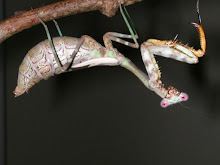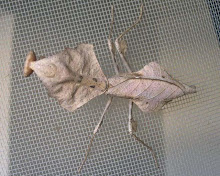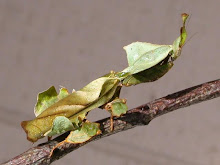Friday, August 17, 2007
Senses
Praying mantids, with their huge compound eyes mounted on the triangular head, have a large field of vision. They use sight for detecting movement of prey and then turn their mobile head to bring their prey into their binocular field of view. They are able to turn their head 180 degrees for excellent vision and hearing. Their antennae are used for smell.
Diet
Being a carnivorous insect, the mantis feeds primarily on other insects. However, it is not uncommon for larger mantis to consume small reptiles and even small mammals or birds.
To capture their prey, mantids use their camouflage to blend in with the surroundings and wait for the prey to be within striking distance. They then use their raptorial front legs to quickly snatch the victim and devour it.
Defense mechanisms
When threatened, praying mantids stand tall and spread their forelegs to allow them to penetrate the target, with their wings fanning out wide and mouths open. The fanning of the wings is used to make the mantis seem larger and to scare the opponent, with some species having bright colors and patterns on their hind wings and inner surfaces of their front legs for this purpose. If harassment persists, the mantis will then strike with their forelegs and attempt to pinch or bite.
Mantids do not develop wings until the final molt. Some mantids do not develop wings at all, or may have small flightless wings. The only time mantids fly is when the adult female begins to emit pheromones which attract males for mating. Contrary to popular belief, not all males become the meal of the female. Male mantids fly at night as they seem to be attracted to artificial lights. Bats, one of the mantid's natural predators, feed at night when the males are busy locating a mate. Bats, as you may know, use echolocation to pinpoint their prey. According to Yager and May, praying mantids are able to hear these sounds and when the frequency begins to increase rapidly, indicating an approaching bat, mantids will stop flying horizontally and begin a descending spiral toward the safety of the ground. Often this descent will be preceded by an aerial loop or spin. Other times, the entire descent will consist of a downward spiral. The mantis has one single ear, its sole purpose being for the detection of bats.
Reproduction
The reproductive process in a majority of mantid species is marked by sexual cannibalism of the male by the female, and is an ongoing subject of research. The reason for sexual cannibalism has been the subject of some debate, with some considering submissive males to be achieving a selective advantage in their ability to produce offspring. This theory is supported by a quantifiable increase in the duration of copulation among male mantids who are cannibalized, in some cases doubling both the duration and the chance of fertilization. This is further supported in a study by J. P. Lelito and W. D. Brown where male mantids were seen to approach hungry females with more caution, and were shown to remain mounted on hungry females for a longer time, indicating that males actively avoiding cannibalism may mate with multiple females. The act of dismounting is one of the most dangerous times for male mantids during copulation, for it is at this time that female mantids most frequently cannibalize their mates. This increase in mounting duration was thought to indicate that males would be more prone to wait for an opportune time to dismount from a hungry female rather than from a satiated female that would be less likely to cannibalize its mate. Some consider this to be an indication that male submissiveness does not inherently increase male reproductive success, rather that more fit males are likely to approach a female with caution and escape
Endangered status
Most North American mantids are not included among endangered species, but species in other parts of the world are under threat from habitat destruction.
Pest control
Mantids will consume any insect. If released in very large numbers they will cause a reduction in number of pest insects. Apply mantids of several sizes for the best results. Release several hundred in batches through out the season as smaller mantids will consume aphids, fruit flies, mites, gnats and mosquitoes. Larger mantids consume flying roaches, crickets, some species of grasshopper, some species of beetles, moths, flies and other larger insects. Rarely, mantids will consume small birds. It is much more common, however, for birds to consume mantids. USDA lists mantids as a beneficial insect.
When releasing mantids into the garden it is best to hatch oothecae (plural for ootheca, egg case) When placing oothecae into the garden they should be placed in partial shade. Areas frequented by ants or small predatory wasps should be avoided. Predatory wasps deposit eggs into mantis ootecae. Some gardeners find it best to hatch mantids indoors then release them outdoors at night 24 hours or so after the hatch is complete. Some people claim that mantids are not efficient as beneficial insects. This will depend on the number of mantids released, how often they are released, positioning of the ootheca when there is human intervention and under what conditions the oothecae are hatched.
Gardeners will often search for oothecae and carefully move them while still connected to their holding structure and place them in the refrigerator to prevent premature hatching. The ootheca will keep the unborn nymphs alive in the refrigerator until the spring arrives and they are ready to hatch. This allows for the mantis nymphs to be born in the garden and spend their lives protecting the plants from insects that may harm the vegetation. Hundreds of thousands of dollars per year are spent by gardening enthusiasts who find the release of mantids to be effective.
When releasing mantids into the garden it is best to hatch oothecae (plural for ootheca, egg case) When placing oothecae into the garden they should be placed in partial shade. Areas frequented by ants or small predatory wasps should be avoided. Predatory wasps deposit eggs into mantis ootecae. Some gardeners find it best to hatch mantids indoors then release them outdoors at night 24 hours or so after the hatch is complete. Some people claim that mantids are not efficient as beneficial insects. This will depend on the number of mantids released, how often they are released, positioning of the ootheca when there is human intervention and under what conditions the oothecae are hatched.
Gardeners will often search for oothecae and carefully move them while still connected to their holding structure and place them in the refrigerator to prevent premature hatching. The ootheca will keep the unborn nymphs alive in the refrigerator until the spring arrives and they are ready to hatch. This allows for the mantis nymphs to be born in the garden and spend their lives protecting the plants from insects that may harm the vegetation. Hundreds of thousands of dollars per year are spent by gardening enthusiasts who find the release of mantids to be effective.
Lifespan
Praying Mantids start out life in an ootheca egg mass. Usually laid in the fall on a small branch or twig, the egg mass then hatches in the spring to early summer as warming temperatures signal the time for birth.
The natural lifespan of a praying mantis in the wild is about 10 - 12 months, but some mantids kept in captivity have been sustained for 14 months. In colder areas, female mantids will die during the winter. Males tend to "suddenly" die about 2 to 3 weeks after mating in the fall, This is usually caused by the female's urge to kill off the male once the egg pouch has been produced. (U.S. Mantids)
Pets
Praying mantids are often kept as pets, their unique behavior and generally easy rearing requirements making them popular in the exotic pet trade, rivaling tarantulas and scorpions. An average-sized insect container or fish tank will make a suitable home. They require branches to climb on, insects to hunt and water to drink. They will drink sprayed water out of a bottle and eat crickets, widely available in pet stores. If fed too much, their abdomen can burst, killing the mantis. Hatchlings should ideally be fed on a diet of fruit flies.
Species
The majority of the about 2,000 species' of mantids worldwide are found in Asia. There are about 20 U.S. native manitds. Two species ( Chinese Mantis, T. sinensis and European Mantis, M. religiosa) were deliberately introduced to act as pest control for agriculture. While it is completely legal to keep U.S. native mantids, Chinese and European mantids in captivity or for the purpose of release on farms or in the home garden (rocker Greg Kihn enjoys keeping and raising them as pets at his home in northern California), all other species of praying mantids are illegal to possess in the United States. Common names for some illegal mantids are : spiny flower mantis, orchid mantis, wondering violin mantis, ghost manits, devils flower mantis, Egyptian mantis among others are illegal under the Non Native Invasive Species Act of 1992. See a more complete list below.
Acanthops falcata - Venezuelan Dead Leaf mantis
Acanthops fuscifolia - Tropical Dead Leaf
Acanthops tuberculata - Tropical Dead Leaf
Acromantis sp. - Boxer mantis
Ameles decolor
Ameles spallanzania
Alalomantis muta - Cameroon mantis
Asiadodis squilla - Asian shield mantis
Blepharopsis mendica - Thistle mantis
Brunneria subaptera - Stick mantis
Brunneria borealis - Stick mantis
Camelomantis sondaica
Ceratocrania macra
Ceratomantis saussurii
Choeradodis rhombicollis - Tropical shield mantis
Choeradodis stalii - Tropical shield mantis
Cilnia humeralis
Creobroter meleagris - Flower mantis
Creobroter gemmatus - Indian flower mantis
Creobroter pictipennis - Indian flower mantis
Creobroter elongata - Flower mantis
Deroplatys angustata - Dead Leaf mantis
Deroplatys desiccata - Dead Leaf mantis
Deroplatys lobata - Dead Leaf mantis
Deroplatys truncata - Dead Leaf mantis
Empusa fasciata
Empusa pennata
Eremiaphila brunneri - Common desert mantis
Eremiaphila zetterstedti
Euchomenella heteroptera - Twig mantis
Gongylus gongylodes - Indian rose/Violin mantis
Gonatista grisea - Grizzled mantis
Heterochaeta strachani
Hierodula membranacea - Giant Asian mantis
Hierodula grandis - Giant Indian mantis
Hierodula patellifera - Indo-Pacific mantis
Hierodula parviceps - Philippine mantis
Holaptilon pusillulum - Jumpy mantis
Hoplocorypha sp.
Humbertiella ceylonica
Hymenopus coronatus - Orchid mantis
Idolomantis diabolica - Devil's Flower mantis
Idolomorpha madagascariensis
Ischnomantis gigas
Iris oratoria - Mediterranean mantis
Liturgusa lichenalis - Lichen mantis
Macromantis hyalina
Mantis religiosa - European mantis
Miomantis caffra - South African mantis
Miomantis paykullii - Egyptian mantis
Miomantis abyssinica - Egyptian mantis
Odontomantis sp. - Ant mantis
Oligonicella scudderi - Scudder's mantis
Orthodera novaezealandiae - New Zealand mantis
Otomantis sp. - Boxer mantis
Oxyopsis gracilis - Peruvian mantis
Oxyopsis peruviana - Peruvian mantis
Oxyothespis dumonti
Paramantis prasina
Parasphendale agrionina - Bud-winged mantis
Parasphendale affinis - African banded mantis
Paratoxodera cornicollis - Giant Malaysian stick mantis
Phyllocrania paradoxa - Ghost mantis
Phyllovates chlorophaea
Plistospilota guineensis
Polyspilota aeruginosa
Popa spurca - twig mantis
Pseudocreobotra ocellata - Spiny flower mantis
Pseudocreobotra wahlbergii - Spiny flower mantis
Pseudovates arizonae - Arizona unicorn mantis
Rhombodera basalis - Giant Malaysian shield mantis
Rhombodera extensicollis - Giant shield mantis
Rhombodera megaera - Giant shield mantis
Rivetina baetica - Ground mantis
Stagmatoptera biocellata
Stagmomantis californica- California mantis
Sphodromantis balachowskyi
Stagmomantis Carolina - Carolina mantis
Stagmomantis limbata - Bordered mantis
Stagmomantis floridensis - Florida mantis
Sibylla pretiosa
Tamolanica tamolana
Tarachodes afzelii
Tarachodula pantherina
Theopropus elegans - Elegant mantis
Tisma freyi
Taumantis sigiana - Lime-green mantis
Tenodera australasiae
Tenodera angustipennis - Narrow-winged mantis
Tenodera aridifolia sinensis - Chinese mantis
Toxodera denticulata - Giant Malaysian stick mantis
Yersiniops sophronicum - Yersin's ground mantis
Yersiniops solitarium - Horned ground mantis
Zoolea lobipes
Acanthops falcata - Venezuelan Dead Leaf mantis
Acanthops fuscifolia - Tropical Dead Leaf
Acanthops tuberculata - Tropical Dead Leaf
Acromantis sp. - Boxer mantis
Ameles decolor
Ameles spallanzania
Alalomantis muta - Cameroon mantis
Asiadodis squilla - Asian shield mantis
Blepharopsis mendica - Thistle mantis
Brunneria subaptera - Stick mantis
Brunneria borealis - Stick mantis
Camelomantis sondaica
Ceratocrania macra
Ceratomantis saussurii
Choeradodis rhombicollis - Tropical shield mantis
Choeradodis stalii - Tropical shield mantis
Cilnia humeralis
Creobroter meleagris - Flower mantis
Creobroter gemmatus - Indian flower mantis
Creobroter pictipennis - Indian flower mantis
Creobroter elongata - Flower mantis
Deroplatys angustata - Dead Leaf mantis
Deroplatys desiccata - Dead Leaf mantis
Deroplatys lobata - Dead Leaf mantis
Deroplatys truncata - Dead Leaf mantis
Empusa fasciata
Empusa pennata
Eremiaphila brunneri - Common desert mantis
Eremiaphila zetterstedti
Euchomenella heteroptera - Twig mantis
Gongylus gongylodes - Indian rose/Violin mantis
Gonatista grisea - Grizzled mantis
Heterochaeta strachani
Hierodula membranacea - Giant Asian mantis
Hierodula grandis - Giant Indian mantis
Hierodula patellifera - Indo-Pacific mantis
Hierodula parviceps - Philippine mantis
Holaptilon pusillulum - Jumpy mantis
Hoplocorypha sp.
Humbertiella ceylonica
Hymenopus coronatus - Orchid mantis
Idolomantis diabolica - Devil's Flower mantis
Idolomorpha madagascariensis
Ischnomantis gigas
Iris oratoria - Mediterranean mantis
Liturgusa lichenalis - Lichen mantis
Macromantis hyalina
Mantis religiosa - European mantis
Miomantis caffra - South African mantis
Miomantis paykullii - Egyptian mantis
Miomantis abyssinica - Egyptian mantis
Odontomantis sp. - Ant mantis
Oligonicella scudderi - Scudder's mantis
Orthodera novaezealandiae - New Zealand mantis
Otomantis sp. - Boxer mantis
Oxyopsis gracilis - Peruvian mantis
Oxyopsis peruviana - Peruvian mantis
Oxyothespis dumonti
Paramantis prasina
Parasphendale agrionina - Bud-winged mantis
Parasphendale affinis - African banded mantis
Paratoxodera cornicollis - Giant Malaysian stick mantis
Phyllocrania paradoxa - Ghost mantis
Phyllovates chlorophaea
Plistospilota guineensis
Polyspilota aeruginosa
Popa spurca - twig mantis
Pseudocreobotra ocellata - Spiny flower mantis
Pseudocreobotra wahlbergii - Spiny flower mantis
Pseudovates arizonae - Arizona unicorn mantis
Rhombodera basalis - Giant Malaysian shield mantis
Rhombodera extensicollis - Giant shield mantis
Rhombodera megaera - Giant shield mantis
Rivetina baetica - Ground mantis
Stagmatoptera biocellata
Stagmomantis californica- California mantis
Sphodromantis balachowskyi
Stagmomantis Carolina - Carolina mantis
Stagmomantis limbata - Bordered mantis
Stagmomantis floridensis - Florida mantis
Sibylla pretiosa
Tamolanica tamolana
Tarachodes afzelii
Tarachodula pantherina
Theopropus elegans - Elegant mantis
Tisma freyi
Taumantis sigiana - Lime-green mantis
Tenodera australasiae
Tenodera angustipennis - Narrow-winged mantis
Tenodera aridifolia sinensis - Chinese mantis
Toxodera denticulata - Giant Malaysian stick mantis
Yersiniops sophronicum - Yersin's ground mantis
Yersiniops solitarium - Horned ground mantis
Zoolea lobipes
Subscribe to:
Comments (Atom)
.jpg)
.jpg)
.jpg)